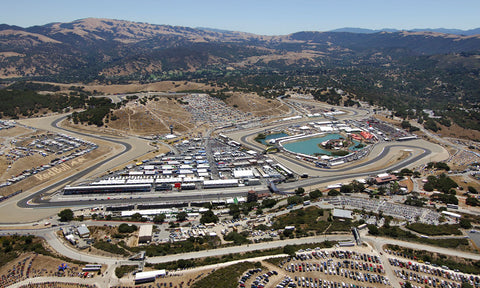What we now call WeatherTech Raceway started it’s life in 1957 as Laguna Seca Raceway near Salinas and Montgomery California. Known mostly for being the home of the Superbike World Championship, Weathertech (or Laguna Seca) Raceway plays an important role in both American Motorsports and Worldwide Motorsports as a whole.
Laguna Seca started out as a lake, which is how it received it’s famous name. Laguna Seca is spanish for Dry Lagoon. The race course was built around the dry lake bed. After the course was reconfigured, two artificial ponds were added. The race track is exactly 2.238 miles long, with a 180 foot elevation change. The track has eleven turns, and of those eleven turns one in particular has become famous.
The circuit's signature turn, the downhill-plunging "Corkscrew" at Turns 8 and 8A set the Laguna Seca apart from other race tracks built around the same time.
When the track was built in 1957, it was built at a cost of $1.5 million, which was raised from local businesses and local individuals after the nearby Pebble Beach Road Races were abandoned for being deemed far too dangerous.
Since 1974, the property was deeded over to the Monterey County Parks Department and continues to be part of the park system to this day.
The first race, which was held on November 9, 1957, was won by Pete Lovely driving a Ferrari. In the intervening years, the track has hosted USRRC, WSBK Superbike World Championship, American Le Mans Series, Trans-Am, IMSA GT, CART, Grand American, Can-Am, Monterey Historic Automobile Races, Formula 5000, Speed World Challenge, AMA (American Motorcyclist Association), and MotoGP motorcycle races.
The track itself has undergone significant changes since it was first built in order for it to meet the evolving safety requirements of the Fédération Internationale de Motocyclisme (FIM), Fédération Internationale de l'Automobile (FIA) and other automotive racing sanctioning bodies.
Changes include the addition of the entire infield area in 1988 (present day turns 3, 4, and 5, eliminating the straight that started at present day turn 2 and ended at present day turn 5) extending the track from its original 1.9-mile length to meet the minimum-track-length criteria of the FIM for MotoGP events, plus the more recent relocation of pedestrian bridges and embankments, and the expansion of gravel pits outside turns 1, 2, 5, 6, 8, 9, 10 for additional runoff.
Also in 2006, the 'hump' at the top of the Rahal Straight was flattened to accommodate the MotoGP riders, though some claim that this increases the wind effects that can perturb a race motorcycle. Remnants of the old configuration can still be seen from the parking lot between turns two and five. They are found underneath a road leading to the parking area for entrant trailers and RVs.
One thing that has remained primarily untouched is the legendary corkscrew.
The famous Turn 8 and 8A combination, popularly referred to as 'the Corkscrew', is considered one of the motorsport world's most challenging turns,due to the 18-meter drop in elevation as well as its blind crest and apex on the uphill approach.
While the track is a favorite of racers and fans worldwide, many focus on one specific section – officially Turns 8 and 8A or, more commonly, The aforementioned Corkscrew.
The Corkscrew is one-of-a-kind in motorsports and here is what makes the hard-left, hard-right combination so spectacular: At the apex to Turn 8 (the lefthander and entry to The Corkscrew), the elevation change is a 12% drop. By the time a race car reaches the apex of Turn 8A (the right hander), the elevation is at its steepest – an 18% drop. The Corkscrew drops 59 feet between the entrance of Turn 8 to the exit of Turn 8A – the equivalent of a 5 ½ story drop – in only 450 feet of track length. From Turn 8 to Turn 9, the elevation falls 109 feet, or just over 10 stories!
It’s no wonder that the biggest claim to fame is the legendary corkscrew.
However that doesn’t mean that the corkscrew is the only famous section of the Laguna Seca, for example, turn 2, with its difficult and technical double-apex, has been renamed the 'Andretti Hairpin', in honor of former Formula 1 World Champion Mario Andretti, while Turn 9 has been renamed 'Rainey Curve' in honor of 500cc Grand Prix motorcycle racing World Champion Wayne Rainey, a resident of nearby Salinas, California.
Furthermore the straight that runs between Turn 6 and Turn 7 has been renamed the 'Rahal Straight' after four-time consecutive Champ Car race winner Bobby Rahal.
Laguna Seca is also the site of the annual Rolex Monterey Motorsports Reunion, formerly known as the Monterey Historic Automobile Races. The event features an extraordinarily eclectic mixture of race cars on the course. The Laguna Seca is considered to be one of the two greatest historic racing events (along with the Goodwood Festival in England).
No matter how you slice it, the Laguna Seca is a living, breathing testament to automotive sports. The second you step into this track, or better yet, the second your tires touch this legendary track, you can feel the history in the asphalt, in the stands, in the air..
If you consider yourself a fan automotive motorsports you owe it to yourself to visit one of the most famous American made racetracks.





Comments
Leave a comment